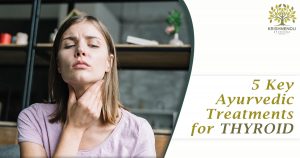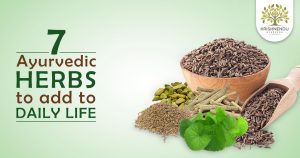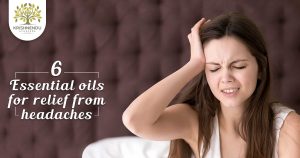Blog
7 Best Ayurvedic Super Foods for Weight-loss and Fat-burn
According to Ayurveda, following a Kapha dosha balancing diet will help in accelerating the weight loss. Along with the diet its recommended to practice active lifestyle like yoga and walking for at least 1 hour every morning on empty stomach for fat-burn. Here are few Ayurvedic superfoods that would help in weight-loss – Bitter gourd Bitter melon or popularly known as bitter gourd can help reducing the weight of white adipose tissue and visceral fat. It can also reduce triglycerides, lipids that contribute towards additional weight gain. Having a glass of bitter gourd juice on empty stomach in the morning is recommended. Bitter gourd also helps in lowering blood sugar levels. Honey According to Ayurveda, honey is a wonderful alternative for sugar/other sweeteners and also its Kapha pacifying. Honey helps in lowering body weight and leptin levels – a hormone that causes weight gain. A glass of lukewarm lemon water with honey in the morning is considered as good ayurveda treatment for weight-loss. Amla Amla is considered the best Ayurvedic super food owing to its incredible therapeutic properties. It is great for boosting digestion, and a healthy digestive system is the key to weight loss. Having a glass of fibre-rich Amla juice daily is recommended. Turmeric Turmeric, the most powerful herb of Ayurveda helps with digestion and weight loss by not allowing fat accumulation. The popular Ayurvedic Golden Milk with turmeric is not only therapeutic but is also a good recipe for weight loss. Ginger Ginger is an ideal Ayurvedic super food for Kapha body types. It aids in weight loss by lowering triglycerides and lipids. The superfood also helps in lowering blood sugar levels and enhances the action of insulin. Having a glass of ginger tea daily is recommended. Green leafy vegetables Green leafy vegetables are the best superfoods in Ayurveda for balancing Kapha dosha and helping in weight loss. Adding them to your regular diet will completely transform your health. Trying Spinach, Kale, Parsley leaves etc. for lunch are recommended. Even salads with leafy greens offer less calories and is ideal for a weight-loss diet. Moong dal One of the most popular Ayurvedic superfoods for weight loss is a nice bowl of Moong Dal Soup. Moong beans are extremely nutritious legumes encompassing fibre, proteins, folic acid, magnesium, B vitamins, iron and zinc. It’s extremely strong in fibre and protein content making you feel full eating less. Above mentioned are the top 7 superfoods for weight-loss. However, it’s recommended to indulge in detoxifying Ayurvedic Panchakarma treatments with the above foods for an ideal weight-loss journey. This will not only help remove the toxins but also aid digestion and improve your energy. For more details on Ayurvedic Panchakarma treatments – Click Here



5 Key Ayurvedic Treatments for Thyroid
Thyroid is an endocrine gland that secretes hormones controlling the rate of activities in your body, mainly related to metabolism. The two main types of thyroid are hypothyroidism and hyperthyroidism, which according to Ayurveda, is linked to the aggravation in kapha and pitta doshas. And to remove these excess doshas in the body, effective ayurvedic treatments are practiced. Hypothyroidism: Hypothyroidism occurs when your body does not produce sufficient thyroid hormones and also due to iodine deficiency. Typical symptoms include abnormal weight gain, hair loss, tiredness, depression, slow heart rate, dry skin and cold intolerance. Hyperthyroidism: Due to excessive production of thyroid hormones and iodine content in the body, a person suffers from hyperthyroidism. They often experience increased appetite, insomnia, tremor, anxiety, inability to concentrate and irregular heartbeat. Here are few key Ayurvedic treatments for Thyroid dysfunctions: Diet People suffering from thyroid dysfunctions are often prescribed high fibre diet with low starch food. Incorporate food items that are rich in iodine, especially for hypothyroidism, like shrimp, salmon, sardine, and eggs in moderate quantity. Eat more fresh fruits, green leafy vegetables, almonds, few walnuts, berries, ginger and apple. And limit the intake of fats and carbohydrates, milk and dairy products, and food with preservatives. Herbs Ayurvedic herb Mahayograj Guggul is considered to be the best remedy for hypothyroidism due to its high iodine content. It calms down all three doshas – vata, pitta, kapha, attributed to thyroid dysfunction. Brahmi, Punarnava and Ashwagandha are also consumed to treat thyroid dysfunction by regulating agni to increase metabolism and strengthen immunity. As these herbs help in regulating metabolism and detoxifying the body, you may need to increase water intake and consult an experienced Ayurvedic physician before consuming. Yoga Yoga helps in stabilizing the thyroid gland by secreting sufficient thyroid hormones. Sarvangasana and Bhujangasana stimulate thyroid gland to control thyroxin. Matsyasana, aka fish pose, stretches your neck not only to stimulate thyroid glands but also reduces stiffness in muscle and prevents depression caused as a side effect of this dysfunction. Another yogasana to be practiced is Halasana or the plough pose which compresses your neck, calms your brain and thereby, reduces stress and fatigue. Also, yogasanas like Ustrasana, Viparita Karani and Marjaryasana-Bitilasana are easy yet effective in treating and preventing thyroid. Meditation People with hypo and hyperthyroidism often complain about depression, lack of energy, anxiety and panic attacks. According to Ayurveda, practicing meditation and pranayama on a regular basis helps in preventing such panic attacks and boosting levels of neurotransmitters and key hormones in the body. Panchakarma treatment Ayurveda recommends Panchakarma for effectively treating thyroid dysfunction. It comprises of Virechana, Basti and Nasyam along with medicines to treat hypo and hyperthyroidism. Being a purification process to flush away excess toxins from the body, Panchakarma is carried out from 8 to 15 days depending on the severity of the dysfunction and based on the prakruti of each individual.



5 Key Ayurvedic Ways to Treat Insomnia
Sleeplessness is your worst nightmare, leaving you exhausted for the whole day. A disorder that stops you from getting sufficient sleep, insomnia has become very much common in this fast-paced life. From irritability to depression, anxiety to lack of concentration, insomnia takes away a large part of your life causing an imbalance for your body and mind. According to Ayurveda, the unhealthy lifestyle followed by people aggravates Vata dosha, causing insomnia. Here are few key Ayurveda recommendations for treating insomnia: Ashwagandha Stress is one of the major causes of insomnia and Ashwagandha is the best solution for it. It reduces cortisol levels, a stress hormone in the body. For best results, consume it as powder, capsule or tablet. Abhyanga Nurture yourself with Ayurvedic massage, Abhyanga regularly to calm your nervous system and pacify Vata and Pita doshas. You can also try massaging your feet with lukewarm mustard oil for 15 minutes every day before going to the bed. Shavasana Shavasana or the Corpse Pose is the best yoga posture for relaxation of body and mind. Practicing Shavasana improves blood circulation and releases tension from your muscles, allowing you to rest more deeply. Practice it regularly before sleeping. Brahmi Brahmi, a pivotal Ayurvedic herb, is known to promote daytime energy and nighttime sleep. Its ability to support the nervous system and mind helps in relaxing your body, thereby promoting quality sleep. Consume Brahmi in the form of powder, tablet or as liquid extract for optimal results. Warm Milk In Ayurveda, warm milk is considered to treat insomnia because of its sleep inducing properties. Have a glass of warm milk combined with a pinch of nutmeg before going to sleep. Using nutmeg will prove to be beneficial due to its sleep-inducing properties and also has a calming effect when consumed in small quantity.



Yogasanas to practice according to your body type
A yogasana is considered to have particular effect on the body which is defined relative to the Ayurvedic constitution which is described through Vata, Pitta and Kapha doshas. And different yogasanas can influence the increase or decrease a particular dosha according to their structural ability. Here is a brief guideline on how an individual body type influences the kind of yoga he should practice. Vata dosha Individuals with a dominant Vata dosha should practice asanas that are calming and grounding by nature. As the lower abdomen, pelvis and large intestines are the residence of Vata in the body, asanas that compress the lower abdomen are considered ideal. Asanas that help strengthen the lower back is also beneficial for alleviating Vata. Uttanasana – The standing forward bend is highly beneficial for Vatas. It tends to be grounding while also assisting in strengthening the spine. Balasana – The child’s pose compresses the pelvis and the Vata region. It is also recommended for Vata disorders like constipation and chronic gas. Dhanurasana – The bow pose puts the pressure in the pelvis and extends the lower back providing maximum relief from Vata. Supta Virasana – The reclining hero pose is yet another recommended asana for Vata. It encourages a mild extension of the lower abdominal muscles and lower back alleviating Vata. Virasana (hero pose), Siddhasana (easy pose) and Padmasana (lotus pose) are calming poses which help counter Vata’s agitated nature. Pitta dosha Asanas that are calming and overly heating are ideal for Pitta dosha. The calming poses help pacify the intensity and ease the emotions they are most prone to. When alleviating the dosha, these asanas are also beneficial for managing conditions like ulcers, hyperacidity, liver disease, etc. Ustrasana – The camel pose opens up the abdomen, solar plexus and chest and also allows free movement of energy through these regions. Bhujangasana (cobra pose) and dhanurasana (bow pose) are also recommended for solar plexus extension. Kapha dosha Stimulating and heating asanas are ideal for countering the heavy, cold and sedated nature of Kapha. Poses that open up the chest are best suited for Kapha as the stomach and chest are the areas where the dosha accumulates and takes on the form of mucuous. These yogasanas are also beneficial for treating and preventing both congestive and constrictive conditions like bronchitis, pneumonia, asthma etc. Setu bandhasana – The bridge pose is one of the beneficial asana for Kapha dosha. It is excellent for opening the chest and improving circulation of energy through the region. Suryanamaskar – Sun salutation is recommended as a good aerobic exercise for Kapha dosha as it is very active, creates heat and opens up the chest.



7 Ayurvedic herbs to add to daily life
Ayurveda has one of the oldest and the most developed herbal system in the world which has also been in continuous since 5000 years. Compiling medicinal and healing properties of thousands of herbs into an herbal healing system, Ayurveda provides insights on how to incorporate them in to our daily lives as well. Here are top 7 Ayurvedic herbs that should be incorporated into daily routine. Ajwain Ajwain or carom seeds are a strong digestive and nerve stimulant. It can function as a weight loss herb by aiding the elimination of toxins that are lodged in the body. An excellent herb to address Vata disorders and to heal painful joints, ajwain can be taken as a tea to help with weight loss. Ashwagandha Hailed as one of the best anti-aging herbs, ashwagandha enhances vitality. It is also helpful for people suffering from stress, tension and also who are overworked. For benefits, take half a spoon cooked in milk. Brahmi The most recommended tonic for the brain and nervous system, brahmi balances the left and right hemispheres of the brain. It aids in the removal of toxins and blockages from the nervous system, helps manage depression, enhances intelligence and improves memory and concentration. Brahmi can be taken boiled in milk or water or as brahmi ghee. Cardamom A natural tranquilizer, cardamom helps neutralize the acidity of coffee and caffeine and the mucus-forming properties in milk. It also helps remove excess Kapha from the stomach and lungs. Drink milk boiled with cardamom before bed or add cardamom powder or pods to coffee when brewing it. Cumin It enhances the digestive system and metabolism while also helping with nutrient absorption. Cumin is recommended for new moms after giving birth to cleanse the reproductive organs and to improve milk secretion. Add cumin in cooking to promote the assimilation of micronutrients. Licorice Licorice is a rejuvenating herb which rejuvenates all body systems and reduces acidity. Use licorice as a sweetener by adding its root to hot tea instead of honey or sugar. Boiling powdered licorice root in a milk decoction is also advised. Neem One of the most powerful blood purifiers and detoxifiers according to Ayurveda, neem is highly beneficial for acne, skin diseases, healing wounds and skin damage. It is also recommended for Pitta disorders, joint pain and muscle aches. Use neem as a medicated oil or leaf paste for benefits.



6 Essential oils for relief from headaches
Essential oils are considered an effective remedy for treating headaches ranging from sinus headache to tension headaches. Containing properties which help expand and contract the vessels, they improve the blood flow and reduces headache in an instant. Essential oils also possess soothing and calming effects which are beneficial for headache relief. Here are some of the essential oils to manage headaches. Peppermint oil The presence of menthol makes it known for the soothing and calming effects on the skin. When applied directly on the forehead, it stimulates blood flow to the brain and aids in muscle contractions. Peppermint oil is beneficial to treat tension headaches as well as for relief from sinus headache. Lavender oil The sweet and soothing oil helps relieve anxiety, depression, stress and nerve relates insomnia, making it ideal for treating anxiety and stress-related headaches. Lavendar oil is also recommended for migraines and hormonal type of headaches. Use the oil through diffusion, inhalation or apply topically. Massage the oil on the temples and neck before sleep for relief from the throbbing pain. Basil oil Basil oil treats headaches by relaxing the pressure on the head muscles. The oil is considered best for migraines and tension headaches. Mix basil oil with a carrier oil and using a cotton ball or fingers, apply it on your scalp and the back of the neck. Eucalyptus oil With expectorant, anti-inflammatory and pain reducing qualities, eucalyptus oil is an ideal remedy for sinus and tension headaches. Inhaling the steam from hot water which has eucalyptus oil dissolved in it provides relief from congestion. Rosemary oil Rosemary oil makes a good remedy for sinus and hormonal headaches due its analgesic and anti-inflammatory properties. It is also a gentle and soothing oil which alleviates pain quickly. Put a few drops of oil in your palms, cup them over your nose and mouth and breathe in and out deeply for relief. Lemon citrus oil Lemon citrus oil has a sharp and refreshing aroma which make sit helpful for curing all types of headaches including migraines, sinus or tension-type headaches. Using a diffuser machine, diffuse the oil for an entire night for relief from congestion and headaches.